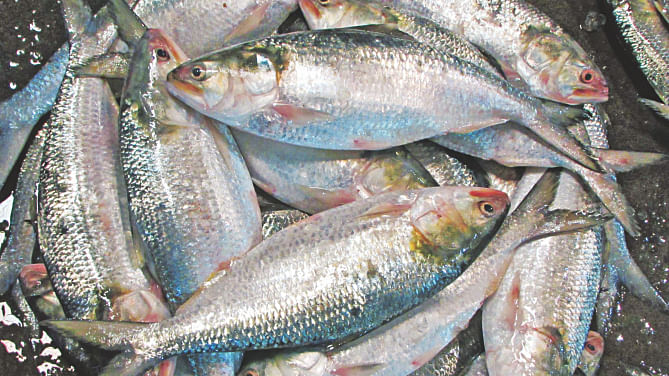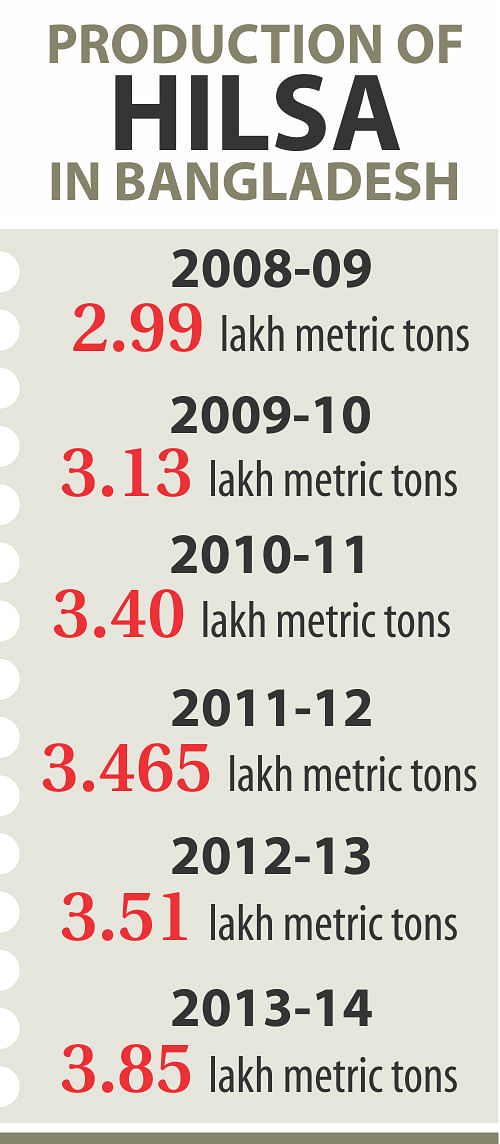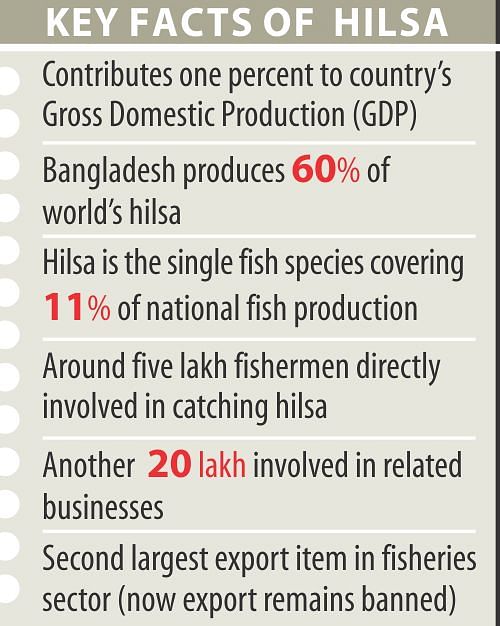Spawning zone not safe yet

Despite the government's efforts to enforce ban on catching brood hilsas during the peak spawning season in October, only around 40 percent of mother hilsas could release eggs in rivers across the country.
It indicates that a huge quantity of brood hilsas had been netted illegally during the ban period from October 5 to 15.

This year, 39.8 percent of mother hilsas spawned eggs while the figure was 41.2 percent last year, according to an estimate by researchers at Bangladesh Fisheries Research Institute (BFRI).
However, the researchers say there would be plenty of hilsas next season if the 26,000 crore hilsa fry, hatched this year, are protected.
“If we could protect these hilsa fry until the next spawning season, hilsa production would be huge. We will get around 1.5 to 1.65 crore of brood hilsas next year,” BFRI Director Anisur Rahman told The Daily Star.
For that to happen, the government must ensure strict monitoring to stop catching of jatka or immature hilsas (less than 25 centimetres) during the ban for eight months from November 1 to June 30, he said.
A mother hilsa lays 2.5 to 25 lakh eggs annually. But a very small portion of those eggs are hatched out, and even a smaller number of fry survive and become mature to spawn eggs, said Anisur Rahman.
Researchers estimate those numbers by counting hilsa fry at some strategic points in rivers after the peak spawning period.
Asked why hilsa spawning was less this year, Anisur Rahman said they found many brood hilsas in the market after the ban period. It indicated that many brood hilsas couldn't lay eggs during the period, he said.
Experts say there is a huge potential for increasing hilsa production in Bangladesh that now accounts for almost 60 percent of global hilsa production.
“Bangladesh could earn lots of foreign currency by exporting hilsas. The country earned Tk 294 crore in 2011-12 fiscal year, exporting 6,173 tonnes of hilsa,” said Dr Hossain Zillur Rahman, executive director of Power and Participation Research Centre.
He recently conducted a research which shows the country produced hilsas worth Tk 16,000 crore (Tk 450 a kg) in FY 2012-13.
 Statistics of the fisheries department show hilsa production was 2.99 lakh tonnes in FY 2008-09. It rose to 3.85 lakh tonnes, more than 11 percent of the country's annual fish production, in FY 2013-14.
Statistics of the fisheries department show hilsa production was 2.99 lakh tonnes in FY 2008-09. It rose to 3.85 lakh tonnes, more than 11 percent of the country's annual fish production, in FY 2013-14.
“It is possible to increase the production further if the government provides more logistic support,” said Zahid Habib, director of Jatka Conservation Project of the fisheries department.
Currently, the department conducts drives during the ban period, hiring staffs from other departments.
“We require dedicated staffs and need to provide them with logistics to conserve jatka for eight months from November to June. Otherwise, it wouldn't be possible to increase hilsa production further,” said Zahid.
Hilsa habitats became limited up to the Meghna river over the years.
However, recent conservation efforts saw migration of hilsas this year through the Padma up to Rajshahi and Murshidabad in India for the first time in the last three decades, he noted.
Brood hilsas start releasing eggs after migrating inwards from the sea, immediately before the full moon of Bangla month of Ashwin. They continue it for a few days after the full moon.
This year, the full moon of the Bangla month was on October 9, and the government imposed a ban on catching all kinds of fish from October 5 to 15.
But in reality, catching of hilsas continued during the period.
During the ban period this year, mobile courts seized around 40.65 tonnes of hilsas and jailed 723 fishermen. The figure was 26.6 tonnes last year.
In order to protect jatka, field-level government officials have proposed extending the ban period.
The fisheries and livestock ministry consulted field-level officials, who suggested extending the ban period to 20 days from 11 days before and after the full moon in Ashwin, said Masud Ara Momi, assistant director (Jatka Conservation Project) of the fisheries department.
The government is now considering this, she said.
Half a million fishermen are provided with livelihood support and 40 kgs of rice a month in compensation for not catching Jatka for eight months, Momi said.
In the past, hilsa could be found in all big rivers of the country. But now it is found in around 10 rivers due to fall in water level and pollution. The rivers are the Padma, Meghna, Jamuna, Paira, Tentulia, Bishkhali, Shibsa, Baleshwar, Kirtankhola and Arialkha.
Since India started withdrawing water of the Ganges by the Farakka barrage, hilsa stopped migrating to many rivers as it prefers around 25 feet deep water and strong currents to go against, say experts.
India's withdrawal of Ganges water resulted in a drop in water level in most rivers of the Ganges water system.

 For all latest news, follow The Daily Star's Google News channel.
For all latest news, follow The Daily Star's Google News channel. 



Comments